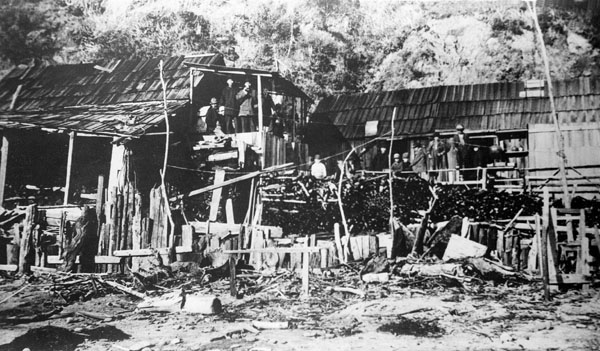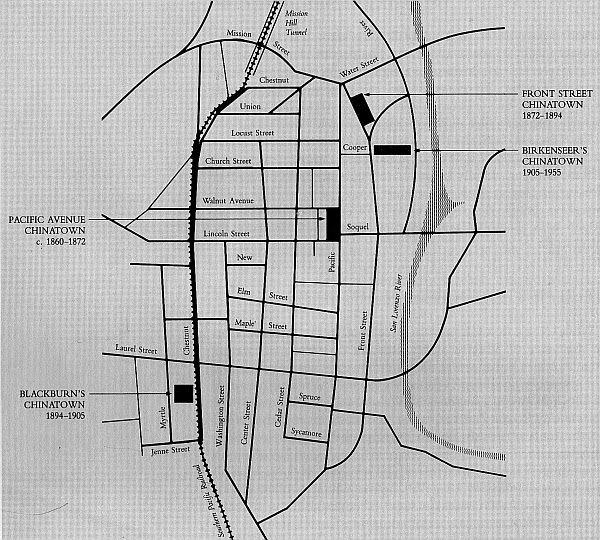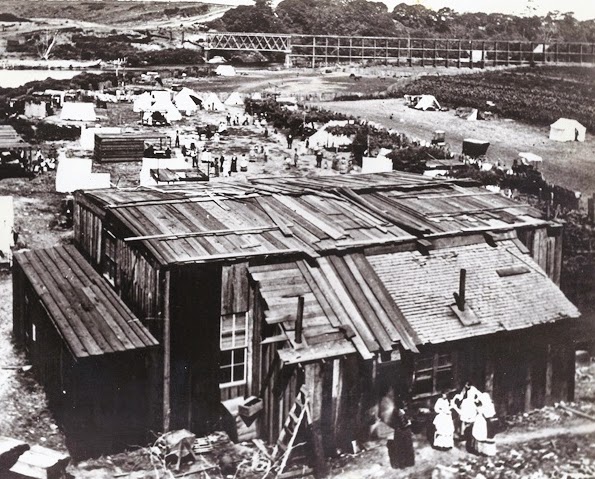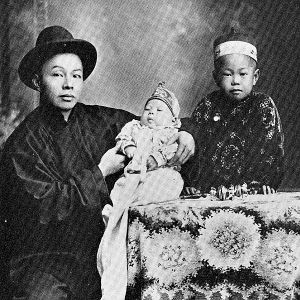History Pages: 33 - Santa Cruz Once Had a Chinatown
For a table of contents, see History pages.
Just as the 1870s were good years to look at a distinctive architectural style called Second Empire, those same years are a good time to look at one chapter in the history of immigration in Santa Cruz. Immigration is once again a hot topic and, of course, the entire history of our area is about immigration – first came the Spanish, then the Americans, then a succession of groups from different parts of the world. By the 1870s, the many European immigrants, and especially the Americans who came west from other parts of the country, were beginning to think of themselves as locals, along with the remaining Spanish-speaking Californios. But another immigrant group came from the opposite direction - across the Pacific from China.
There is some evidence that our coast was visited by Chinese fishermen well before the first Spanish explorers, and a number of Chinese certainly came to Mexico (and may have visited the Alta California coast) as crew on the "Manila galleons" in the period from 1565-1815.
After California became part of the US of A in 1848, some Chinese fishermen, who lived aboard their boats with their families, settled on the shores of Monterey Bay - notably around the Monterey Peninsula, although there was one Chinese fishing village in Santa Cruz County on what is now New Brighton Beach (photo) and another near the mouth of the Pajaro River. North of Davenport there's a coastal cliff called "China Ladder" because Chinese abalone fishermen in the area once built a descending structure enabling them to access the waters below.
The first influx of substantial numbers of immigrants from mainland China came during the Gold Rush years, beginning in 1848. By that time, the British had established trading bases in Hong Kong and Canton, and made regular stops at ports along the California coast. News of the gold discovery raced across the Pacific as fast as the trade winds could carry the ships. Arrival of the news coincided with a period of civil and economic unrest in southern China, convincing many residents of that area to leave home to search for better fortune at Gum Shan, the Golden Mountain.
Some of these mainland Chinese came as prospectors or merchants, but many ended up as fishermen or doing whatever work they could get - as cooks, gardeners, launderers and railroad builders. In many cases, they became the preferred type of menial worker because they were more dependable, working harder and longer for lower wages than others. Most immigrants to the Golden Mountain landed first in San Francisco before moving on up the Sacramento River to the gold country. As with others drawn by dreams of striking it rich, however, most Chinese immigrants didn’t find a lot of gold but many found other reasons to stay in locations throughout northern California.
During the 1860s and 70s, two small Chinese communities existed in and near Santa Cruz. The California Powder Works employed and housed a group increasing from a dozen to almost three dozen, most as coopers (barrel makers). Beginning in the mid-1860s, a small Chinatown grew up in Santa Cruz, on Pacific Avenue south of Walnut (see map), around a few laundries, stores and one small cigar factory. Other Chinese worked at the various logging and lime manufacturing operations, or banded together to rent plots of land to grow produce for local sale. Some of the more prosperous residents began to employ Chinese domestics.
When gold mining began to decline, many of the excess Chinese laborers were hired by the railroads. The western end of the first transcontinental railroad was built largely with Chinese labor, although that fact was excluded from commemorative photographs. Once the transcontinental link was completed in 1869, some of the now-experienced Chinese railroad workers moved back to California to help build virtually all of the local rail lines. The one notable exception was the Mission Hill tunnel, completed in 1876 by a crew of Cornish miners.
Those Cornish miners were a symptom of an all-too-common historical phenomenon that reared its ugly head – anti-immigrant feelings. The first anti-Chinese laws followed the Gold Rush and, by the mid-1870s, local anti-Chinese sentiments were running so high that Santa Cruz city officials brought in that Cornish tunneling crew, for higher pay, just to avoid hiring Chinese workers.
Another result of the railroad construction was the beginning of large-scale commercial agriculture in the region. One of the first local manifestations of that trend was the sugar beet operation set up on Soquel Creek from 1874 to 1879. An earlier post on this blog described how Claus Spreckels made his fortune, first in Hawaiian sugar cane and later in locally-grown sugar beets. Even earlier, however, the factory and fields in what is now Capitola Village (at far upper right in the 1875 photo below) were successful. One of the main factors in that success was the willingness of Chinese workers to do the hands-and-knees labor required to cultivate sugar beets. As demand for sugar increased, sugar beet operations moved to more spacious fields and a larger factory in Watsonville, and still later to the Spreckels company town near Salinas.
Ironically, the Chinese-built railroads brought a burst of new economic activity to Santa Cruz, at a time when much of the country was still struggling to recover from the "Panic of 1873". The railroad-induced prosperity increased the rents of the Pacific Avenue Chinatown properties, which caused the Chinese businesses to look for new homes (and/or those landlords were no longer willing to rent to the Chinese). The Chinese found new low-rent digs a couple of blocks away, on Front Street (mostly on the river side), between Water and Cooper Streets. The increasing prosperity of Pacific Avenue was paralleled by the decreasing fortunes of Front Street, which by this time had become the saloon and “red light” district. Those qualities also, of course, kept the rents low.
In the 1880 census, thirty-eight of the ninety-eight Chinese counted in Santa Cruz lived on Front Street. That sounds like a minuscule number until you realize that the total population of Santa Cruz in 1880 was only 3,998. In those days, “redevelopment agency” could have been a euphemism for fire, flood and other “acts of God”. The aging wooden buildings (twenty years old was considered “aging” for those hastily-constructed 1850s buildings) the Chinese community moved into along Front Street were fires waiting to happen, and it’s perhaps remarkable that they lasted as long as they did. Several hotels and other businesses on the north end of Front Street were destroyed in an 1887 fire, but only one Chinese business – a laundry. The remainder of the Front Street Chinatown lasted until the great fire of 1894, which destroyed a large swath of the neighborhood.
The 1882 Chinese Exclusion Act stopped all immigration from China, including the families of the mostly-male earlier arrivals. Resident Chinese immigrants were also deprived of the right to become citizens or to own property. The ban on Chinese immigration was not repealed until 1943. Without the opportunity to marry and start families, some of the local Chinese men returned to China but many could not afford to go back. So they stayed, aged, and gradually died off.
A very few of those first Chinese immigrants did establish families and eventually prospered in Santa Cruz, like proud father Quong Chong, shown in this 1890 photo (left). They assimilated, like millions of other immigrants before and since. There’s no longer a reason to have a Chinatown in Santa Cruz. The last, mostly empty buildings of the last Santa Cruz Chinatown were demolished after the 1955 flood and never rebuilt.
Some of the last Chinatown residents were members of the Lee family. George Lee grew up to become a professional photographer, and his photographs of the old neighborhood are our best pictures of life on China Lane.
Sources
- John L. Chase, The Sidewalk Companion to Santa Cruz Architecture (4th ed. 2023), see "Chinatown" in the Index.
- George Lee, Chinatown dreams: the life and photographs of George Lee (2002 book), Geoffrey Dunn, editor; contributions by Lisa Liu Grady, Tony Hill, James D. Houston, Sandy Lydon, Morton Marcus, George Ow, Jr.
- Sandy Lydon, Chinese Gold: The Chinese in the Monterey Bay Region, 1985, Capitola, CA: Capitola Book Co. (credit for the Chinatown map)
- Sandy Lydon and Carolyn Swift, Soquel Landing to Capitola-by-the-Sea (1978 book), California History Center, De Anza College.



